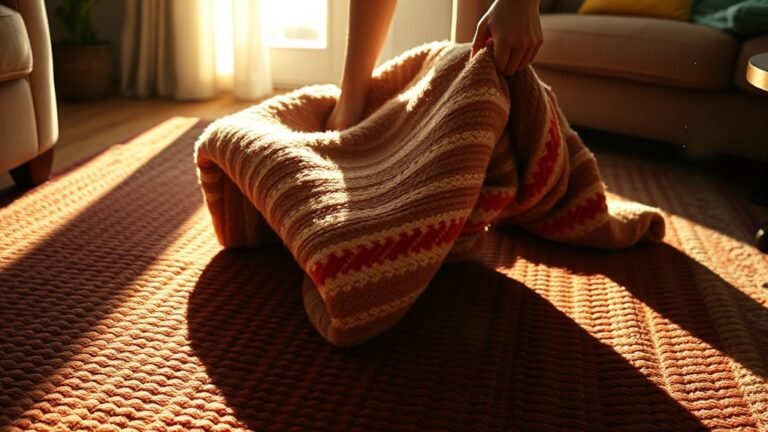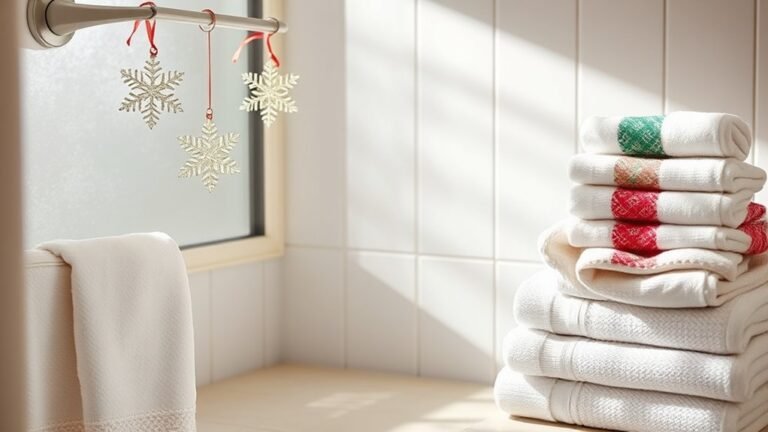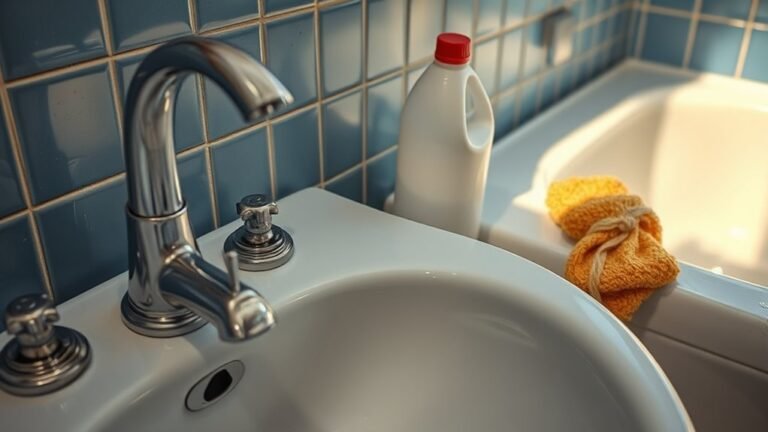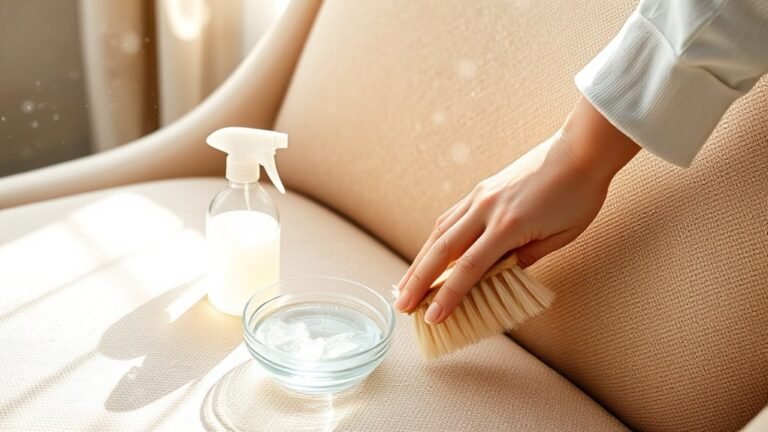How to Clean and Deodorize Your Windowsills
To clean and deodorize your windowsills, start by gathering soft brushes, microfiber cloths, and eco-friendly cleaners like vinegar solutions. Remove dust and debris with a handheld vacuum, then tackle stains using mild detergents or a baking soda paste. For natural deodorizing, spray herbal infusions or citrus water, and sprinkle baking soda to neutralize odors. Finally, maintain regular cleaning and monitor moisture to prevent mold buildup. There’s more to effective upkeep that guarantees your windowsills stay fresh and protected.
Gather the Necessary Cleaning Supplies
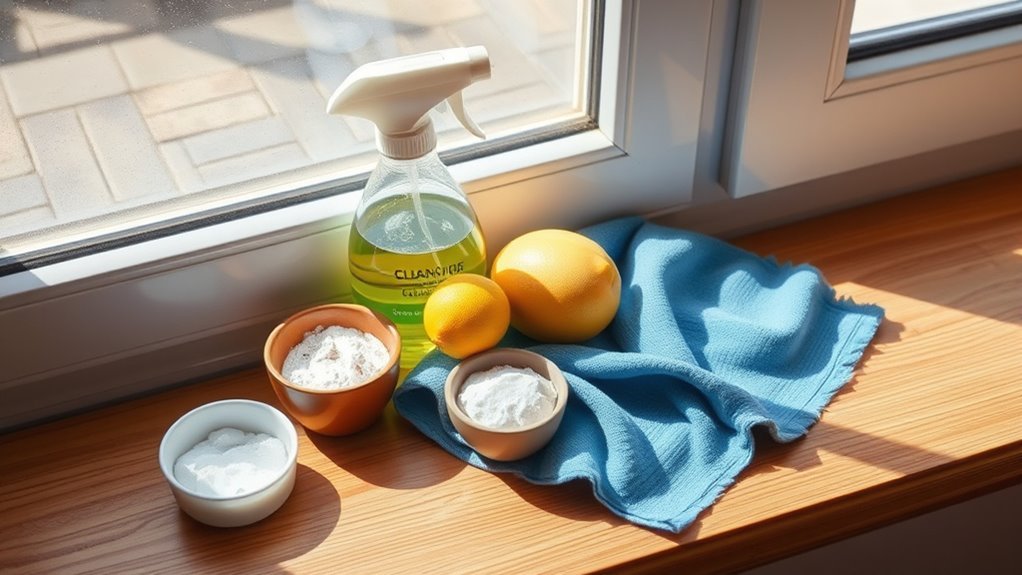
Before you begin cleaning your windowsills, you’ll need to gather a few essential supplies. Start by selecting effective cleaning tools that suit the task, such as soft brushes, microfiber cloths, and a small handheld vacuum if you prefer. These will help you access tight corners and delicate surfaces without causing damage. Next, opt for eco friendly supplies to maintain a sustainable routine; natural soaps, vinegar solutions, or biodegradable sprays are excellent choices that don’t compromise your indoor air quality. Avoid harsh chemicals that restrict your freedom to breathe freely and clean safely. Having these prepared before you start guarantees efficiency and a more thorough job, allowing you to tackle your windowsills with confidence and care while respecting your environment and personal well-being.
Remove Dust and Loose Debris
Start by removing all dust and loose debris from your windowsills using a soft brush or handheld vacuum. Employ effective dusting techniques by gently sweeping the brush along corners and crevices where particles accumulate. A handheld vacuum with a brush attachment can efficiently capture fine dust, preventing it from scattering. Focus on debris removal before applying any cleaning solution to avoid smearing dirt. Pay attention to window tracks and edges, as these areas often harbor hidden buildup. Taking this initial step guarantees a clean surface and prepares your windowsills for deeper cleaning. By mastering these dusting techniques, you maintain freedom from allergens and maintain a fresh environment. Consistent debris removal not only improves appearance but also prolongs the life of your windowsills by preventing damage caused by grit and grime.
Treat Stubborn Stains and Grime

Although removing dust clears the surface, stubborn stains and grime often require targeted treatments to restore your windowsills effectively. Start by selecting appropriate grime busters—mild detergents or specialized stain removal solutions designed for your windowsill material. Apply the cleaner directly to the affected areas and let it sit briefly to break down buildup. Use a soft brush or cloth to gently scrub, focusing on crevices where grime accumulates. For tougher stains, a paste of baking soda and water can provide additional abrasion without damage. Always rinse thoroughly with clean water to remove residue and prevent discoloration. By tackling these persistent marks methodically, you maintain both the appearance and longevity of your windowsills, ensuring they remain a clean, inviting frame to your view.
Deodorize Your Windowsills Naturally
Once you’ve tackled stains and grime, it’s important to address any lingering odors that can detract from your windowsill’s freshness. Opt for natural deodorizing methods like herbal solutions and citrus sprays to maintain a clean, inviting space. These options neutralize odors without harsh chemicals, giving you freedom from synthetic scents.
| Method | Ingredients | Application Tip |
|---|---|---|
| Herbal Solutions | Lavender, rosemary | Brew herbs, let cool, spray |
| Citrus Sprays | Lemon, orange peel | Mix peels with water, spray |
| Baking Soda | Pure baking soda | Sprinkle, let sit, vacuum |
Choose a method that fits your style and enjoy a naturally fresh windowsill every day.
Prevent Future Buildup and Odors

To keep your windowsills clean and odor-free, establish a regular dusting routine to prevent dirt buildup. Applying a protective sealant can create a barrier that resists moisture and stains. These steps will help maintain a fresh and well-preserved surface over time.
Regular Dusting Routine
Regularly dusting your windowsills is essential to prevent buildup and lingering odors. By maintaining a consistent dusting routine, you’ll enhance your window care and extend the life of your cleaning techniques. Use a microfiber cloth or a soft brush to gently remove dust without scratching surfaces. Aim to dust at least once a week, especially in high-traffic or dusty areas. Here’s a simple schedule to keep you on track:
| Day | Tool Recommended | Notes |
|---|---|---|
| Monday | Microfiber cloth | Removes fine dust |
| Wednesday | Soft brush | Reaches corners easily |
| Friday | Vacuum with brush | For heavy dust buildup |
| Sunday | Damp cloth | Cleans residual grime |
| Monthly | Mild cleaner | Deep clean & deodorize |
Sticking to this routine empowers you to keep windowsills fresh and odor-free.
Use Protective Sealants
Maintaining a consistent dusting routine helps keep windowsills clean, but applying a protective sealant can take your efforts further by preventing future buildup and odors. Before sealant application, verify the windowsill is thoroughly clean and completely dry. Protective coatings create a barrier that repels dust, moisture, and contaminants, reducing grime accumulation and minimizing odor retention. Use a brush or cloth to apply an even layer of sealant, paying close attention to edges and corners where dirt tends to collect. Allow the sealant to cure as per manufacturer instructions to maximize effectiveness. By incorporating protective coatings into your cleaning regimen, you empower yourself to maintain fresh, clean windowsills with less frequent deep cleaning, freeing you to enjoy your space without constant upkeep concerns.
Tips for Maintaining Clean Windowsills Regularly
To keep your windowsills consistently clean, establish a daily dusting routine that prevents dirt buildup. You’ll also want to monitor moisture levels to avoid mold growth, especially in humid environments. Selecting the right cleaners tailored to your windowsill material guarantees effective maintenance without damage.
Daily Dusting Routine
Although daily dusting might seem like a small task, it’s key to keeping your windowsills spotless and free from buildup. Regular daily cleaning prevents dust accumulation, which can attract allergens and diminish your living space’s freshness. To maintain clean windowsills effortlessly, stick to this routine:
- Use a microfiber cloth to trap dust without spreading it.
- Gently wipe corners and edges where dust gathers.
- Dust before vacuuming or mopping to avoid resettling particles.
- Incorporate dusting into your morning or evening ritual.
- Avoid harsh chemicals that can damage paint or wood.
Preventing Mold Growth
Since windowsills are prone to moisture buildup, you’ll want to address potential mold growth before it starts. Effective mold prevention begins with consistent moisture control. Regularly wipe down your windowsills with a dry cloth to remove any lingering dampness, especially after rain or condensation. Verify your windows are properly sealed to minimize water intrusion, and consider using a dehumidifier in rooms where humidity tends to rise. Ventilation also plays a vital role in mold prevention; open windows or use exhaust fans to reduce indoor humidity. By maintaining dry, well-ventilated windowsills and promptly addressing any signs of water accumulation, you’ll greatly reduce the risk of mold formation. Staying proactive with moisture control not only keeps your windowsills clean but also preserves your home’s air quality and structural integrity.
Choosing Effective Cleaners
Keeping moisture at bay is just one part of maintaining clean windowsills; selecting the right cleaning products plays a significant role in preserving their condition. When choosing cleaners, you want effective solutions that safeguard both your home and the environment. Consider these options:
- Eco friendly cleaners that reduce chemical exposure and environmental impact
- Commercial options designed specifically for tough stains and mold prevention
- Mild detergents for routine dust and dirt removal without damaging surfaces
- Disinfectants with mold-fighting agents to maintain hygiene
- Natural alternatives like vinegar or baking soda for gentle, non-toxic cleaning
Frequently Asked Questions
Can I Use Vinegar on Painted Windowsills?
You can use vinegar on painted windowsills, but you should do so cautiously. Vinegar benefits include natural cleaning and deodorizing, but its acidity might dull or damage painted surfaces if used undiluted. To protect your paint, dilute vinegar with water—usually a 1:1 ratio works well—and test a small, hidden area first. This way, you get effective cleaning without sacrificing the finish or your freedom to maintain your space safely.
How Often Should Windowsills Be Deep Cleaned?
You should follow frequency guidelines that fit your environment and lifestyle when setting a cleaning schedule for deep cleaning windowsills. Typically, deep cleaning every 3 to 6 months works well to remove accumulated dirt and prevent odors. If you live in a dusty area or have pets, you might want to clean more often. Sticking to a consistent schedule guarantees your windowsills stay fresh and well-maintained without feeling like a chore.
Are Commercial Deodorizers Safe for Windowsills?
You might wonder if commercial deodorizers are truly safe for your windowsills. The truth is, many contain harsh chemicals that can damage paint or wood finishes and pose safety concerns for your health. For a safer, more natural alternative, try baking soda or essential oils—they’re gentle yet effective. By choosing these, you maintain your freedom from harmful substances while keeping your space fresh and protected.
What Causes Mold Growth on Windowsills?
Mold growth on your windowsills happens mainly because of excess moisture and poor humidity control. When warm, humid air meets the cooler surface of the windowsill, condensation forms, creating a perfect environment for mold. To prevent this, focus on mold prevention by improving ventilation and reducing indoor humidity levels, especially in damp areas. Keeping your windowsills dry and well-ventilated helps you maintain a healthier, mold-free space effortlessly.
Can Pets Affect Windowsill Cleanliness?
Imagine a pristine windowsill interrupted by scattered pet hair and a faint, lingering odor. Yes, pets can affect windowsill cleanliness by shedding fur and transferring scents that accumulate over time. To keep your space fresh, focus on thorough pet hair removal using a vacuum or lint roller, followed by odor removal techniques like natural sprays or baking soda. This methodical approach lets you maintain freedom from unwanted mess and smells.

